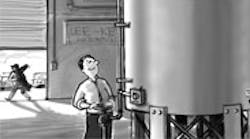Flow with the go
Problem 203 — Easy in, even more easily out, as this month’s problem by James K. Hesch of Santa Fe, N.M., demonstrates.
“Why, it’s no problem at all,” quipped Lucius Bluff. “I’ll stay late myself and personally see that the tank gets filled. It’ll take less than an hour!”
The scene was the board room of the Lee Key Hydraulic Company, and Bluff was extoling his new holding tank for water- based hydraulic fluid (assume water) to company president Horatio Puff. The tank consisted of a large cylindrical tub 8 ft in diameter and 10 ft high. There was a 1-in.-diam port on the side at the bottom of the tank. Hydraulic fluid entered the tank from a spigot that ran at 65 gpm.
At 5:00 p.m., as Puff put on his overcoat and stepped out to the executive parking lot, Bluff busied himself around the tank. At 5:10 he turned on the fill spigot and the float switch and left for the day. The switch had been set to turn off the spigot when the tank was 90% full.
Unfortunately he had left the port open. Assume the port’s discharge coefficient is 0.61 and is a constant. Does the float switch activate, and if so, how long before it turns the spigot off? Does Bluff have a mess on his hands (and in his shoes) by the following morning?
Send your answer to:
Fun With Fundamentals
POWER TRANSMISSION DESIGN
1100 Superior Ave.
Cleveland, OH 44114-2543
Deadline is April 10. Good luck!
Technical consultant, Jack Couillard, Menasha, Wis.
Solution to last month’s problem 202 — You have it all sewn up if you answered 2 in. Here’s how Grandma was able to needle Horton:
Let: l = Length of pillowcase, number of stitches w = Width of pillowcase, number of stitches b = Width of border, number of stitches
It is stated in the problem that 35,953 is the total number of stitches on the pillowcase, 22,113 of which are inside the border.
The number 35,953 is the product of two prime numbers, 229 and 157. These two numbers, therefore, are the length and width, l and w. You can now set up the following quadratic equation:
(1 - 2b)(w - 2b) = 22,113
lw - 2bw + 4b2 = 22,113
Plug in the values, l = 229 and w= 157 to get the following:
35,953 - 314b - 458b + 4b2 = 22,113
4b2 - 772b = -13,840
b2 - 193b + 3,460 = 0
If you made use of the hint: Let p be the height of the previous pillowcase.
p x w = 15,229 and l x w = 35,953.
Use Newton’s method to find the largest common denominator w , which is 157. The previous needlepoint is 97 stitches high by 157 wide.
